Ukraine Conflict Monitor - 14 October – 20 October 2023
Situational report from the war in Ukraine
Please consider becoming a paid member of our Substack channel to support our work in providing high-quality information about the war in Ukraine and the political-military situation in Belarus. This will help us greatly to provide you with more content.
Coming up, we will assess Russian actions and objectives in Avdiivka.
Key takeaways from last week’s developments:
Both sides continued ground attacks in their respective key areas, but the results of these battles were minimal; the overall outlook remained unchanged, although Russian determination to encircle Avdiivka is noteworthy;
No frontline changes were reported in the Kharkiv Oblast; Artillery attacks on residential and civilian areas continued;
Russian attacks in the northern part of the Luhansk Oblast (Synkivka – Ivanivka – Kyslivka), although intensified, were repelled; The frontline in other parts of the region remained unchanged;
From the frontline perspective, no changes occurred in the Donetsk Oblast; Russians, however, continued to attack Ukrainian positions near Avdiivka; Despite preponderance of manpower and equipment, Russians made minor confirmed gains;
In the Southern Direction, Ukrainians made marginal gains in the Velyka Novosilka and Orikhiv axes; The outlook for the ongoing counteroffensive remained unchanged in that Ukrainian progress is too slow to deliver meaningful gains;
Not only did Ukrainians maintain their presence on Dnipro’s left bank in the Kherson Oblast, but they also launched assault groups in a relatively significant cross-river operation; Ukrainians made some gains initially but were reportedly pushed back; Nevertheless, small bridgeheads were maintained;
Last week, Russians launched several missile attacks on Ukraine, and although the number of missiles fired was small (20), only 25% (four) were reportedly intercepted; The intensity of kamikaze drone strikes also decreased from 69 two weeks ago to 27 last week.
Executive summary
Last week delivered no operational, let alone strategic, changes in Ukraine. Both sides continued attacks in their respective key areas. Ukrainians made some marginal gains in the Southern Direction and launched a cross-Dnipro attack on Russian positions on the river’s left bank in the Kherson Oblast. On the other hand, Russians maintained attacks in the northern parts of the Luhansk Direction and continued attempts to encircle Avdiivka in the Donetsk Oblast. These efforts delivered no confirmed frontline changes.
As such, just by looking at the frontline, the past week was rather uneventful. However, we assess that the last week again emphasised that autumn is unlikely to be calm.
Starting from the Ukrainian side, Kyiv’s forces will likely continue attacking Russian positions on Dnipro’s left bank and they will attempt to expand existing bridgeheads. While they have the capacity to achieve this objective, moving deeper into Crimea will be very difficult without a significant expansion in the number of forces involved in the attack (please click here to access our analysis on Ukrainian options in the Kherson Direction).
Secondly, last week, Ukrainians launched several MGM-140 ATACMS M39 (165 km-range cluster munitions variant) missiles on Russian air bases in Brdyansk and Luhansk. As a result of these strikes, Russians lost at least several helicopters destroyed. Some airframes, which did not explode, could have been damaged by shrapnel and are now beyond repair. It is unclear how many missiles Ukraine received. We assess that Washington did not pass the ATACMS with unitary warheads that could engage targets at 300 km ranges. Speaking to the Drive in SEP2023, the head of Ukraine’s Military Intelligence, General Kyrylo Budanov, said that 100 missiles would not make a difference and that Kyiv would need hundreds at ATACMS to impact the battlefield. Likewise, the variants are important, too, as the target sets for unitary and cluster munitions variants vary.
Next, we need to consider that Russians will adjust to the threat. Sure, the successful attacks on air bases highlighted probable Russian intelligence gaps in collecting information about the adversary’s forces, its inability to predict its actions and its inability to respond to the threats posed by new weapon systems. A similar situation occurred when HIMAR’s GLMRS was introduced to the battlefield, which surprised Russians. They nevertheless dispersed and adjusted after a few weeks.
Lastly, I believed in July that while ATACMS may have been useful for Ukraine, Kyiv needed different capacities to keep the offensive going. The key objective was to push south, and given Ukrainian needs at that time, they would be served better if, instead of receiving ATACMS, they obtained more (cluster munitions) artillery shells, demining equipment, tanks, IFVs, anti-tank guided missiles, counterbattery radars, etc. Now that the pace of Ukrainian attacks has declined, weather conditions are deteriorating, and Russians are preparing their forces for autumn-winter attacks, Ukrainian needs have changed. Kyiv may be at a disadvantage over the coming months, and it will need capabilities to interdict the movement of Russian forces from the rear towards the frontline. ATACMS and other long-range systems will thus play an important role in these attempts. The introduction of Ground Launched Small Diameter Bombs by winter will also impact Russian preparations, combat effectiveness, and ability to assemble forces and to sustain their attacks.
Russians will also try to influence Ukrainian decision-making. Firstly, as we have said many times, we assess that Moscow’s reserves are not depleted and that they will be able to launch multiple attacks across different axes. Secondly, the delivery of artillery munitions from North Korea will likely greatly impact the intensity of Russian artillery fires. On the other hand, it is difficult to see what Russians can do differently apart from expanding the scope and intensity of their ground attacks. While the number of equipment and personnel deployed to the frontline could increase, no new (conventional) capabilities could be introduced that would significantly impact the frontline. Russia is thus expected to throw men and equipment. But the ongoing battle for Avdiivka has again shown how difficult it is to capture heavily fortified areas and that heavy attrition is bound to happen. Managing it (for both sides) is key.
Ukraine battle map
Please click here to access our interactive map and click here to access the archive.
The situation at selected axes and directions
From this week, we will add more charts depicting units deployed by both sides in specific directions. The ones below present a general number of units (brigades, regiments, separate battalions). From next week on, we will provide breakdowns of each direction to show the type of units and their numbers. There are two important caveats. Firstly, we attach medium confidence to this data, although the reader should know that we make changes to Russian and Ukrainian ORBATs daily. Secondly, the unknown column shows the number of units for which we don’t know their current whereabouts.
Kharkiv Oblast Direction
(This section only covers ground developments in the northern Kharkiv Oblast and Russian artillery strikes across the entire region).
No changes occurred in the Kharkiv Oblast over the past seven days. According to Oleh Synehubov, the head of the Kharkiv Oblast administration, Russians continued to shell civilian infrastructure in the Kharkivsky, Bohodukhivsky, Kupyansky, Izuimsky and Chuhuivsky districts. In particular, last week Russians shelled Druzhelyubivka, Kupyansk, Lyman Pershyi, Synkivka, Kucherivka, Ivanivka, Kyslivka, Berestove, Holubivka, Pertropavlivka and Podoly, Pishchane, Borova, Hlushkivka, Vovchansk, Yurchynkove, Neskuchne and Udy, and Hatyshche.
No cross-border land attacks occurred.
Luhansk Oblast Direction
Although Russians continued to attack Ukrainian positions in the Luhansk Oblast over the past seven days, they made no confirmed territorial gains.
On Saturday (14OCT), Oleksandr Syrskyi, Commander of the Ukrainian Land Forces, claimed that the situation in the Kupyansk and Lyman sectors had escalated significantly. After suffering losses, the Russians recovered in two months and launched attacks near Makiivka in the Luhansk Oblast and later in the Kupyansk direction in the Kharkiv Oblast. Syrskyi stated that the Russian main goal was to defeat Ukrainian troops, encircle Kupyansk and reach the Oskil River. He added that daily, the Russians carry out dozens of assault group attacks supported by armoured vehicles and heavy mortar and artillery fire. Despite this, he said, Ukrainian units continued to hold the ground. Indeed, while some small frontline changes could have occurred, Russians made no confirmed gains.
Serhii Dibrov, the 21st Separate Mechanised Brigade spokesperson, explained on Sunday (15OCT) that in the Lyman-Kupyansk direction, Russians could not get closer than three kilometres to the Ukrainian positions due to the work of Ukrainian drones. So far, Russian attacks had delivered big losses. He added that Russians no longer relied on big assaults, as they did last summer. Instead, they focused on small unit attacks. Concurrently, Dibrov noted that Russians were saving munitions, which the Ukrainian soldier attributed to “something happening to” Russian supplies. We have mentioned this many times previously, but Russians were conserving artillery munitions, likely due to a lack of artillery shells.
According to a Russian journalist, on Saturday (14OCT), Russian units advanced a little near Orlyans’ke, but Ukrainian sources did not report any changes/attacks during the weekend. On Sunday (15OCT), Russian reports indicated that Russians conducted an offensive with artillery support near Ivanivka and captured some Ukrainian positions. The same source said that Russians also tried to attack near Synkivka on Sunday (15OCT) but were unsuccessful. Ukrainian sources did not report changes/attacks near these settlements. However, on Sunday (15OCT), Ukrainian bloggers claimed that Russians continued to attack near Lyman Pershyi and Orlyans’ke, but the source failed to provide detailed information about these developments.
Another Russian source stated on Monday (16OCT) that Russian units continued attacks in the Kupyansk direction. Supported by artillery and aviation, Russian units gradually advanced towards Synkivka, where the UAF’s 105th Separate Territorial Defence Brigade held the line. The source claimed that due to the “problematic situation”, Ukrainians reinforced their presence near Dvorichna with a tank subunit from the 41st Separate Mechanised Brigade. In addition, the 3rd Battalion of the 54th Ukrainian Separate Mechanised Brigade arrived in vicinity of (IVO) Dvorichna. A similar transfer was also noted in the south-east of Kupyansk. Up to 150 “Ukrainian Volunteer Army” soldiers arrived at Novoosynove, Petropavlivka and Pishchane. To allow continuous equipment supply, pontoon crossings had been restored in Kupyansk and Kupyansk-Uzlovoye. The source said on Monday (16OCT) that according to some information (unclear what information), the Ukrainian command intends to launch a counterattack to regain previously lost positions.
Regarding the frontline, neither Russian nor Ukrainian sources reported changes near Kuslivka, Krohmalne and Petpopavlivka during the week.
No changes occurred near Dvorichna, Svatove or Novoselivske.
It only shows that operations around Kupyansk have sucked up significant parts of the military potential on both sides, and little capacity exists to launch ground attacks elsewhere in the northern parts of the Luhansk Direction.
According to the Ukrainian source, on Sunday (15OCT), Russians resumed their offensive towards Novojehorivka, but no further information about the attack was published since.
On Tuesday (17OCT), the same source claimed that Russian forces had resumed attacks near Serhiivka and Raihorodka. But in this case, too, no further data has been provided since about frontline changes or the scope of the attack by either Russian or Ukrainian sources.
The Russian source asserted on Sunday (15OCT) that Russian forces continued to attack near Makiivka but were unsuccessful. Neither Russian nor Ukrainian sources reported any changes near Novovodyane Ploshchanka and Chervonopopivka. Also, no changes/attacks were reported near Nevske, Terny, Yampolivka and Torske.
In the Kreminna area, positional battles continued near Dibrova and Serebryansky forest. Neither Russian nor Ukrainian sources reported change during the week.
No changes were reported near Bilohorivka.
According to the Ukrainian source on Monday (16OCT), Ukrainian forces shot down a Russian Mi-8 helicopter in the Luhansk region.
According to Sergey Zybinskyi, a Russian Western Group of Forces Spokesperson, in the Kupyansk direction, Russian units of the “Western” group of troops repelled 37 Ukrainian attacks conducted by elements of the 68th Jaeger Brigade and the 14th, 32nd, 43rd, 44th and 115th Mechanised Brigades near Ivanivka, Synkivka, Novojehorivka, Makiivka and Tymkivka(?) in Kharkiv region. Russian Su-34 fighter-bomber aircraft carried out air strikes on Ukrainian command and observation posts and temporary deployment points of units of the 40th, 41st, 43rd, 115th Mechanised Brigades, 95th Airborne Assault Brigade and 7th Separate Rifle Battalion near Stepove(?), Holubivka, Kupyansk-Vuzlovyi and Pishchane, Novoselivske and Petropavlivka. Russian Ka-52 and Mi-28 attack helicopters and attack aircraft carried out missile and bombing strikes against Ukrainian concentration areas of the 95th Airborne Assault Brigade, the 14th and 32nd Mechanised Brigades and Territorial Defence units near Synkivka, Ivanivka and Leonivka(?). In addition, Russian heavy flamethrower systems carried out three strikes against a concentration of manpower in the positions of the 32nd Mechanised Brigade near Ivanivka and Tymkivka(?).
According to Aleksandr Savchuk, a Russian Centre Group of Forces Spokesperson, in the Lyman direction, 25 attacks by Ukrainian assault groups of the 21st, 63rd, 67th Mechanised Brigades, 12th “Azov” Special Forces Brigade and the 5th Brigade of the Ukrainian National Guard were thwarted and repelled IVO Yampolivka, Dibrova and Serebryansky forest areas.
Russian artillery struck Ukrainian concentration areas of the 21st, 63rd, and 67th Mechanised Brigades, 1st Special Purpose Brigade and 110th Territorial Defence Brigade near Yampolivka, Torske, Dibrova, Serebryansky forest and Hryhorivka.
(The data on Russian fortifications comes from Black Bird Group/DefMon)
Donetsk Oblast Direction
The most important event last week in the Donetsk Direction was the continuation of Russian attacks near Avdiivka. Yet, despite this, Russians made no gains in the area, and the frontline across the entire region remained unchanged.
No changes occurred near Spirne, Verkhnokamyanske, Vyimka and Ivano Darivka. Also, no changes were reported near Rozdolivka, Fedorivka, Vasyukivka and Vesele.
Positional battles continued near Berkhivka, Orikhovo-Vasylivka and Dubovo-Vasylivka, but neither Russian nor Ukrainian sources reported changes during the week.
The same pertains to Bakhmut.
According to the Russian journalist, on Saturday and Sunday (14 – 15OCT), Russian forces continued attacking Ukrainian positions near Andriivka and Klishchiivka but were unsuccessful. The same source also claimed that the UAF still controlled the dominant heights as of Sunday (15OCT). A Ukrainian soldier, who fights in the Bakhmur direction, claimed on Saturday (14OCT) that Ukrainian forces reached the railway. Heavy battles continued near Kurdyumivka as Russians deployed additional forces, but the Ukrainian units continued to counterattack. On Sunday (15OCT), the Ukrainian bloggers asserted that battles continued near Klishchiivka and Odradiivka. However, no detailed information on these developments was provided. On Tuesday (17OCT), the Russian journalist claimed that the UAF had managed to advance northeast of Klishchiivka, but Russians continued to occupy positions over the railway.
No changes occurred near Ivanivske, Bila Hora, and Niu-York. Neither Russian nor Ukrainian sources reported changes/attacks.
On Saturday (14OCT), a Ukrainian source claimed that the Ukrainian 110th Separate Mechanised Brigade repelled another Russian attack near Krasnohorivka. The source said the Russians were actively storming this area to cut off the road near the settlement. Furthermore, Russian forces reportedly continued to conduct offensive operations on the northern flank of Avdiivka. The source claimed that with artillery support, Russian units advanced a little near Stepove. Russian troops also tried to attack near Keramik but were unsuccessful.
On Thursday (19OCT), Ukrainian bloggers claimed that Russians resumed their offensive from Krasnohorivka. A Russian convoy with many vehicles began to move towards the railway line to gain a foothold for the future operation towards Stepove. However, the source said that the Russian attack was repelled due to the joint work of the artillerymen of the 31st and 110th Separate Mechanised Brigades and the Separate Presidential Brigade. On Wednesday (18OCT), the same source said that Russians had lost at least 63 pieces of armour and military equipment on the northern flank of the Avdiivka axis. Almost all equipment was destroyed near Krasnohorivka. However, the source noted that this Russian offensive was yet another proof of the ineffectiveness of the armoured fist tactic when one side concentrates its equipment and tries to succeed on the battlefield by the superiority in numbers. They also added Ukrainians had previously destroyed Russian columns in the Orikhiv and Velyka Novisilka axis and near Vuhledar, Novojehorivka, Makiivka, Andriivka, Mariinka, and now Krasnohorivka and Vodyane-Pervomaiske. These actions directly result from close and growing cooperation between aerial reconnaissance and artillery.
Russian attacks near Avdiivka continued. According to the Russian source, on Sunday (15OCT), Russians assaulted Ukrainian positions near the city, but made no progress. On Monday (16OCT), a Ukrainian soldier who fights in the Avdiivka direction said that after active Ukrainian artillery fire, Russians stopped conducting offensive operations and focused on consolidating their gains. However, the soldiers stated they were preparing for a new offensive, actively using combat aircraft (up to 4-5 daily strikes) and artillery. On Tuesday (17OCT), Oleksandr Shtupun, spokesman for the joint press centre of the Tauride (Zaporizhzhia and Kherson Oblasts) Defence Forces, also confirmed that the intensity of the Russian offensive near Avdiivka decreased. However, he said that the Russians continued to try to encircle the city, although they were less active. He also added that Russian positions had been reinforced with “Storm” and “Storm-Z” units. On Wednesday (18OCT), a Russian blogger claimed that Russians, supported by artillery, conducted offensive operations on the southern, western and north-western approaches to Avdiivka. On Thursday (19OCT), a Ukrainian source added that Russians launched another large-scale offensive towards Avdiivka. Later, the same Ukrainian source stated that Ukrainian units repelled the Russian attack.
According to the Russian source, on Saturday (14OCT), the UAF regained several positions near Pervomaiske and Sjeverne. On the other hand, the same source claimed on Sunday (15OCT) that Russians attacked near Pervomaiske with artillery support and captured some ground. The source also claimed that Russians tried to regain the initiative near Sjeverne by attacking using many (sub?)units. Ukrainian sources did not report any changes/attacks. On Tuesday (17OCT), Russians reportedly achieved partial success near Vodyane and Opytne. However, no detailed information was provided. Also, on Tuesday (17OCT), a Russian source asserted that Russian troops, supported by artillery and aircraft, managed to expand the control zone near Pervomaiske and Sjeverne. The source failed to provide detailed information about this development.
Neither Russian nor Ukrainian sources reported changes near Tonenke and Nevelske.
According to the Russian source, on Saturday (14OCT), the Russian Armed Forces managed to advance from the direction of Solodke and captured some positions that had been lost in the summer. They also advanced near the Novomikhailivka. Neither Russian nor Ukrainian sources reported changes near Pobieda during the week.
In the Vuhledar area, on Monday (16OCT), a Ukrainian source said that Ukrainian units had made tactical advances near Vuhledar. The source also claimed that Russians were bringing new reserves to the area and preparing for the counterattack.
Vitaliy Barabash, the Head of the Avdiivka City Military Administration, claimed on Saturday (14OCT) that Russian forces had been tasked with reaching the administrative borders of the Donetsk region by the end of the year and that the likely capture of Avdiivka was essential to attain this objective. He explained that if they capture the heights near Avdiivka, it will be easier to reach Pokrovsk. So far, we have heard of several deadlines that Putin reportedly presented to the military, and therefore, we treat such comments with a pinch of salt. Likewise, it is clear that capturing Avdiivka is key to allowing further movement. So far, these attempts brought no visible results.
According to Brigadier General Oleksandr Tarnavskyi, Commander of the Tavria (Kherson and Zaporizhzhia Oblasts) Operational and Strategic Group of Forces, during the past week, Ukrainian troops shot down three Russian Su-25 aircraft in the Donetsk Oblast. On Thursday (19OCT), another source claimed that Russians lost five Su-25s in 10 days, presumably all near Avdiivka.
According to Vadym Astafiev, a Russian South Group of Forces Spokesperson, in the Donetsk Direction, Russian units repelled 26 Ukrainian attacks near Orikhovo-Vasylivka, Andriivka, Klishchiivka, Kurdyumivka, Dubovo-Vasylivka, Pervomaiske and Mariinka. Russian aviation struck Ukrainian concentration areas of the 10th Mountain Assault Brigade, 28th, 42nd, 53rd, 67th, 93rd and 110th Mechanised Brigades, 112th Territorial Defence Brigade and 79th Air Assault Brigade near Kurduymivka, Bilohorivka, Bila Hora, Heorhiivka, Khromove, Mariinka and Andriivka.
Southern Ukraine direction
Neither side possesses capacities to commence a decisive attack to break the deadlock in the Southern Directions. We continue to see tit-for-tat attacks, which brought some frontline changes but had no impact on the overall situation in the region.
Velyka Novosilka axis
The past seven days saw no changes in the Velyka Novosilka axis.
The intensity of Ukrainian operations decreased significantly, to the point that Russian and Ukrainian sources either no longer provide updates on the situation in this axis or assert that no significant developments happened. The intensity of Russian attacks also decreased.
The Ukrainians did not conduct an offensive to regain lost positions either north of Pryyutne or east of Urozhaine. No changes occurred near Novomayorske and Novodonetske. Neither Russian nor Ukrainian sources reported changes/attacks during the week.
No changes occurred near Staromaiorske or Levadne.
The Orikhiv axis
Ukrainians continued attacks on Russian positions throughout the week. That said, Russians were also offensively active. Neither side made confirmed gains.
On Saturday (14OCT), Russian troops launched a counterattack on UAF strongholds west of Verbove. The source claimed that despite the 82nd Airborne Assault Brigade’s resistance, Russians recaptured several Ukrainian positions. The source also added that the area was “totally mined”. Nevertheless, the Verbove area is where Russians were reportedly very active.
Probably in response to these Russian activities, on Monday (16OCT), Ukrainians launched artillery strikes on Russian strongholds northwest of Verbovе, which was followed by a ground attack (elements of the 82nd Air Assault Brigade – up to six company groups supported by armoured vehicles – Marder IFV and Leopard tanks). Yet, the source explained that Ukrainians advanced only in one position, which was later struck by Russian artillery. Although Ukrainians had one battalion in reserve, which could be used for another assault, further attacks were suspended from Monday on.
On Tuesday (17OCT), Ukrainian bloggers said Russia had sent reserves for a large-scale counterattack in the Orikhiv axis. The source failed to provide the exact direction of the Russian counterattack. However, on Tuesday (17OCT), the Russian journalist claimed that Russian troops launched a counterattack along Kopani – Novodanylivka from the southwest of Robotyne and near Verbove. Still, the source failed to provide any detailed information about the developments or their results. On the other hand, on Tuesday (17OCT), Oleksandr Shtupun, spokesman for the joint press centre of the Tauride (Zaporizhzhia and Kherson Oblasts) Defence Forces claimed that the Ukrainian Defence forces had partial success west of Verbove and have advanced about a kilometre. He also said that Russians continued to use the “Meat Wave” by sending the Russian “Storm” and “Storm-Z” units to attacks.
Indeed, a Russian source added on Sunday (15OCT) that due to the failure of the Ukrainian offensive near Robotyne–Verbove, the Ukrainian command moved their attention to the Kopani area. The source claimed that the UAF advanced on Sunday near the settlement, but after Russian artillery strikes, the UAF retreated. Also, the UAF’s movements near Novodanylivka and Novoandriivka continued. On Monday (16OCT), Russians reportedly abandoned their positions north of Kopani under heavy fire from Ukrainian artillery. The Ukrainian Armed Forces also advanced southwest of the village.
So far, we have seen no evidence supporting the claim that Ukrainians progressed anywhere in the Orikhiv axis.
Another Russian journalist said on Sunday (15OCT) that Russian forces tried to counterattack near Novopokropivka but were unsuccessful. The same source also asserted on Monday (16OCT) that Ukrainian troops tried to attack near Verbove but also failed.
No changes occurred near Pyatykhatky. Neither Russian nor Ukrainian sources reported changes.
According to Oleg Chekhov, a Russian Eastern Group of Forces Spokesperson, in the South Donetsk direction, Russian forward units, supported by artillery, repelled an infantry attack by the 128th Territorial Defence Brigade of the UAF near Staromaiorske. In cooperation with army aviation and artillery, Russian units hit Ukrainian concentration areas of the UAF’s 79th Airborne Assault Brigade and 58th, 72nd Mechanised Brigade and 128th Territorial Defence Brigade near Novomykhailivka, Urozhaine, Vuhledar and Mykylske. Fifteen attempts to rotate UAF units at strongholds near Novomykhalivka, Urozhanine, Makarivka, Staromaiorkse, Malynivka, Pryyutne and Poltavka were thwarted. Also, Russian artillery fire destroyed an ammunition depot in Vuhledar and two vehicles with Ukrainian manpower near Velyka Novosilka. Russian aviation and artillery fire hit Ukrainian concentration areas of the 58th Motorised Brigade, 79th Airborne Assault Brigade, the 72nd Mechanised Brigade and the 127th, 128th Territorial Defence Brigade near Novomykhailivka, Vodyane, Vuhledar and Pryyutne.
Kherson Direction and Crimea
The frontline remained largely unchanged over the past seven days. However, a reported cross-Dnipro Ukrainian attack indicated that Kyiv is willing to conduct more attacks in the region.
Firstly, on Sunday (15OCT), the Russian source reiterated what had been coming from Russian sources for a couple of weeks: Despite artillery and air strikes, Ukrainians were preparing to cross the Dnipro. The source added that Ukrainians were counting on a vast number of watercraft and a lightning-fast landing force, which should completely seize the islands within a few hours, after which quickly deployable pontoon crossings would be employed.
These predictions were partly realised on Monday (16OCT) when a Ukrainian sabotage and reconnaissance reportedly group landed on the left bank of the Dnipro River. The group, which came from a bridgehead northwest of Pidstepne, attacked positions near the Kozachi Laheri. Another Ukrainian group, which had landed on Frolov Island the previous day, began shelling the village of Krynky. The attacks coincided with increased GMLRS strikes and cluster munitions artillery strikes on Russian positions. Despite this, Ukrainian attacks were repelled. Also on Monday, Russian sources recorded the movement of Ukrainian military columns along the Inhulets River,
Indeed, on Tuesday (17OCT), two assault groups from the 35th and 36th Marine Brigades, supported by artillery and FPV drones, crossed the Dnipro. One group probably captured Poima, while the other moved towards Pishchanivka, which ultimately was not taken. Russians claimed that following the liberation of Pishchanivka, Ukrainians aimed at Pidstepne, but this never occurred.
The size of the Ukrainian attack is also unclear. Although some sources indicated that the 36th Marine Brigade was readying to deploy elements of two battalions for a total of up to 300 personnel to get the attack towards Pidstepne moving.
At the same time, north of Kozatsky and Melky islands, several more Ukrainian naval assault groups were preparing to attack the Kozachi Laheri – Krynky line. The source said the Ukrainian troops were transferring weapons and ammunition from the Ihulets area all day.
Elements of the Ukrainian 35th and 36th Marine Brigades appeared to have made a foothold, although they were constantly struck by Russian artillery. On top of that, Russians reportedly launched Iskander missiles on elements of the 36th Marine Brigade, preparing to cross the river. Some sources indicated that Ukrainians withdrew from Poima by the end of Wednesday.
Since then, relatively little information has appeared regarding the state of the Ukrainian attack. On Thursday (18OCT), Russians said that a temporary deployment point of Ukrainian units was discovered near Kozatske but was destroyed.
The most noteworthy Ukrainian success occurred on Tuesday (17OCT) when Ukrainians struck Berdyansk and Luhansk Airports, both actively used by Russian forces.
Ukrainians most likely used ATACMS M39 cluster munition missiles and destroyed and damaged several helicopters (one source claimed 21 in both strikes), an air defence launcher, and other pieces of airfield equipment – ammo, airstrip, etc.)
Summary of losses
According to the Russian Ministry of Defence, since the start of the war, Ukraine has lost 500 aircraft (+12), 252 helicopters (+2), 8,104 UAVs (+314), 441 anti-aircraft missile systems (launchers?)(0), 12,778 tanks and other armoured combat vehicles (+232), 1,165 MLRS launchers (+2), 6,837 field artillery guns and mortars (+84), as well as 14,463 units of special military vehicles (+320).
According to the Ukrainian General Staff, Russia lost (eliminated) 292,060 personnel (+6,140), 5,047 tanks (+116), 9,557 armoured combat vehicles (+244), 7,012 artillery systems (+205) and 822 MLR systems (+11), 548 anti-aircraft systems (+2), 320 aircraft (+4) and 324 helicopters (+8), and 5,326 UAVs (+62), 1,535 cruise missiles (+4), 20 warships and boats (0), submarines 1 (0), 9,370 vehicles and fuel tanks (+167), and 985 special vehicles (+18).
(Numbers in parentheses denote a weekly change)
Russian air and missile strikes on Ukraine
Regarding Russian missile and kamikaze drone strikes, the past seven days showed increased employments compared to the previous seven days.
Ukrainian Air Force Command reported several missile strikes. On Monday (16OCT), Ukrainians claimed that one Iskander ballistic missile and five Kh-59 TV-guided cruise missiles were fired, of which two Kh-59s were intercepted.
The following day, Russians fired one Kh-59, which was intercepted.
Lastly, on Thursday (19OCT), Russians fired five Iskanders, one Kh-59, and one Kalibr cruise missile. Ukrainians intercepted one Kh-59.
However, what stood out was a small interception rate. Ukrainians claimed that Russians fired 20 missiles over the past seven days, but only four were shot down, and none were an Iskander. The missile interception rate was only 20%.
The Ukrainian General Staff reported 52 battlefield missile strikes, compared to 13 two weeks ago.
The number of Shahed 131/136 strikes decreased. Although the number of strikes increased from two to three, the number of Shaheds dropped from 69 two weeks ago to 27 over the past seven days. Ukrainians claimed the interception rate at 74%.
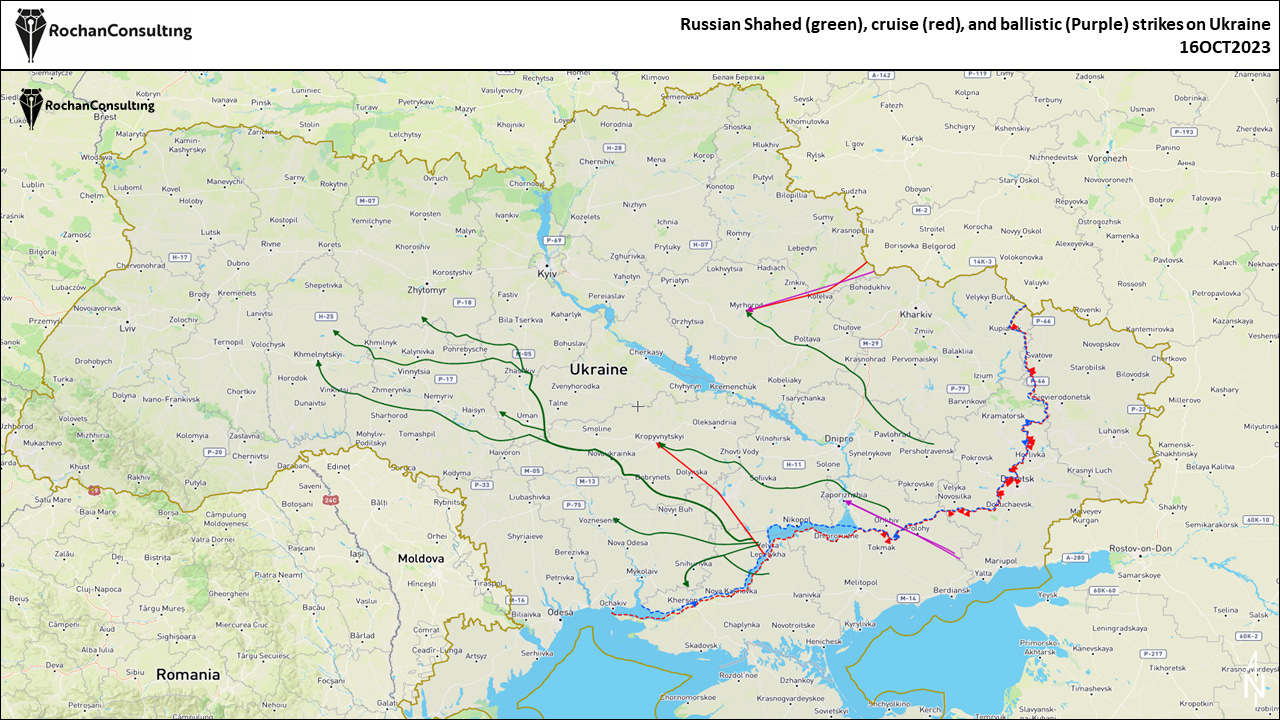
The intensity of Russian ground attacks remained high. They appear to have peaked on Wednesday when 80 assaults were reported, a decrease from 108 attacks on 10OCT. Nevertheless, the moving average now points to slightly less than 80 daily attacks. The average also showed a small decrease over the past seven days when 60 and 69 attacks were reported on 14 and 17OCT, respectively. Next week will show whether Russians can sustain the tempo of attacks, especially since the recent increase is mostly driven by Russian attacks near Avdiivka.


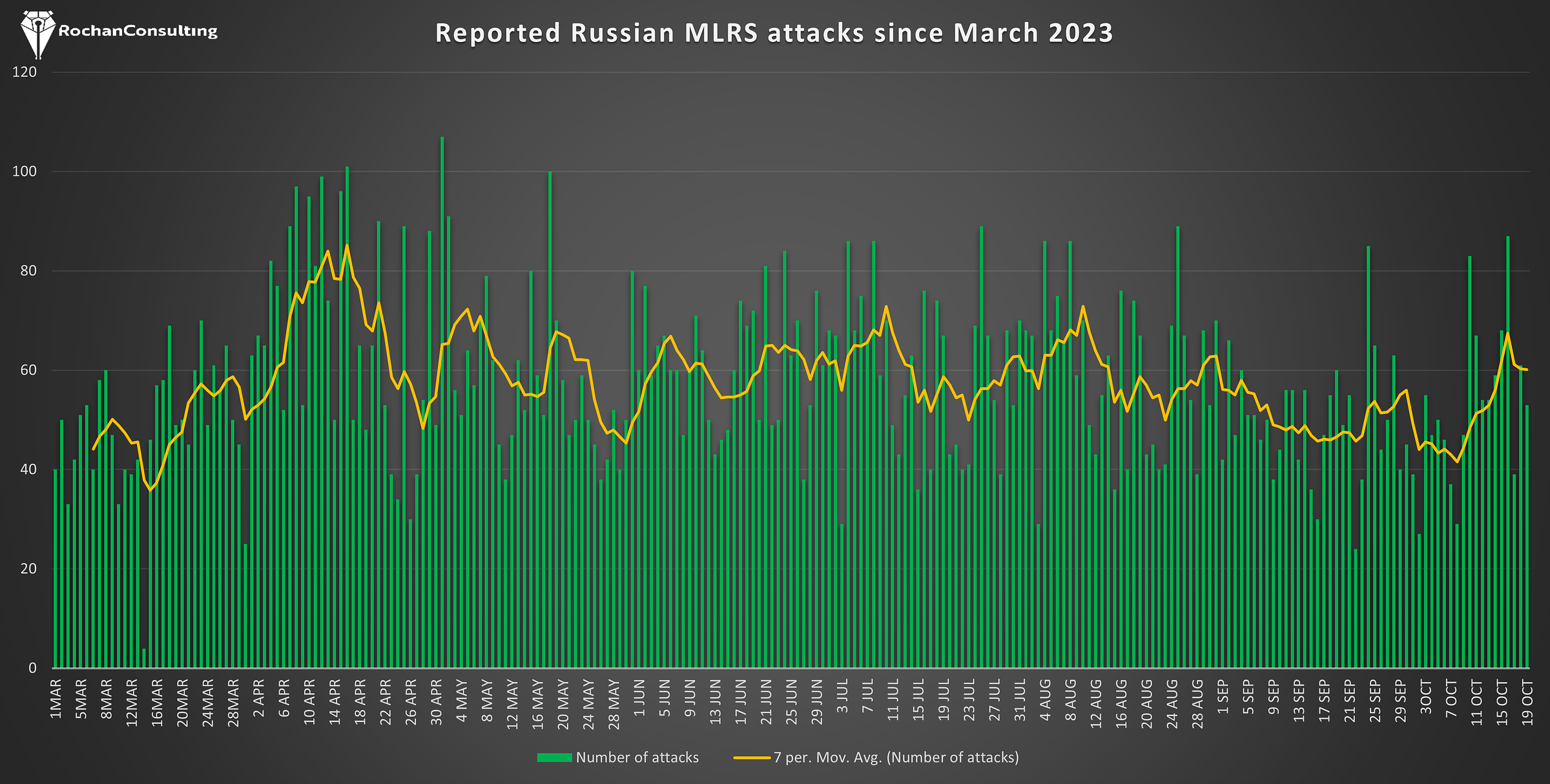
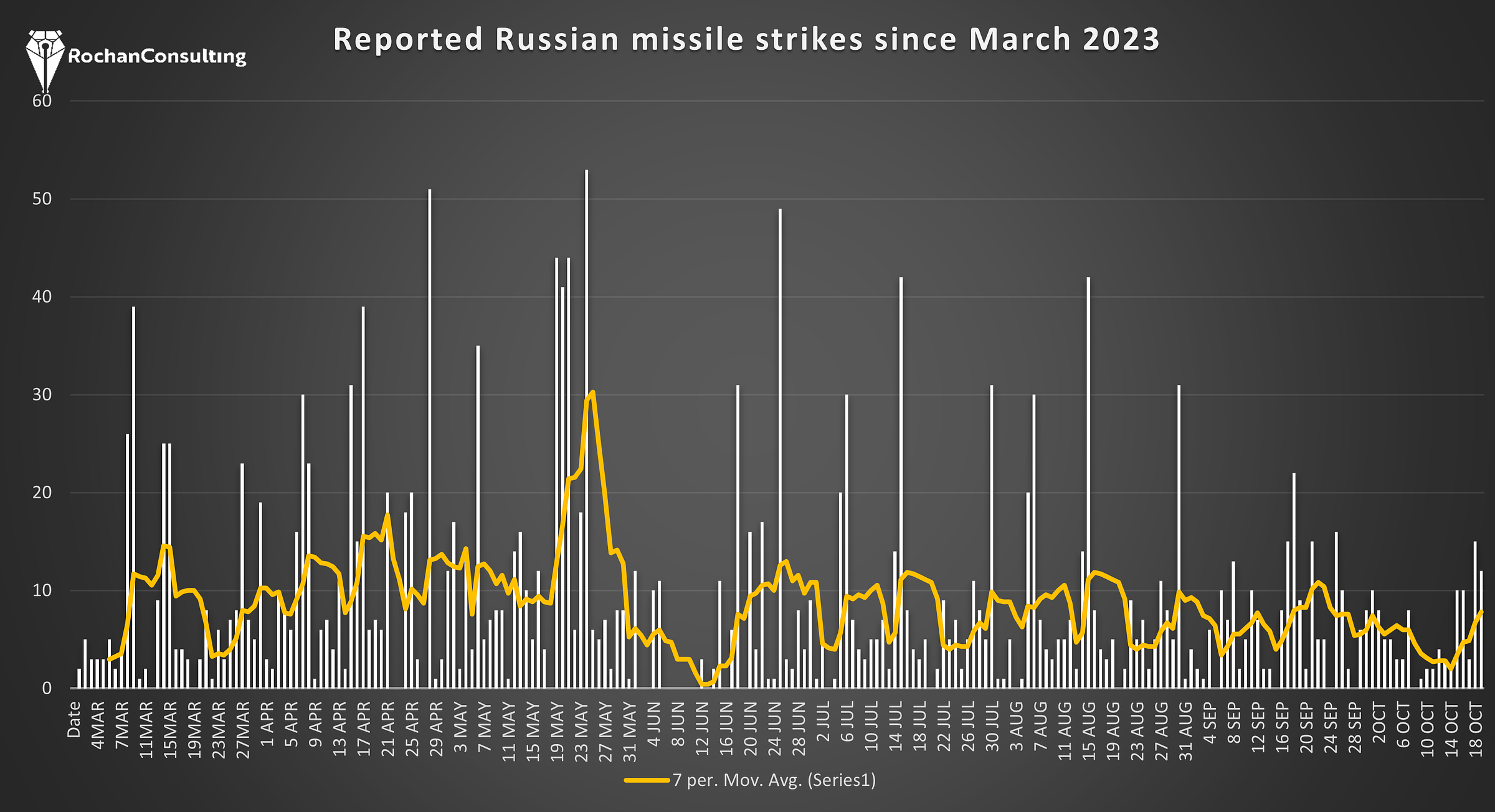
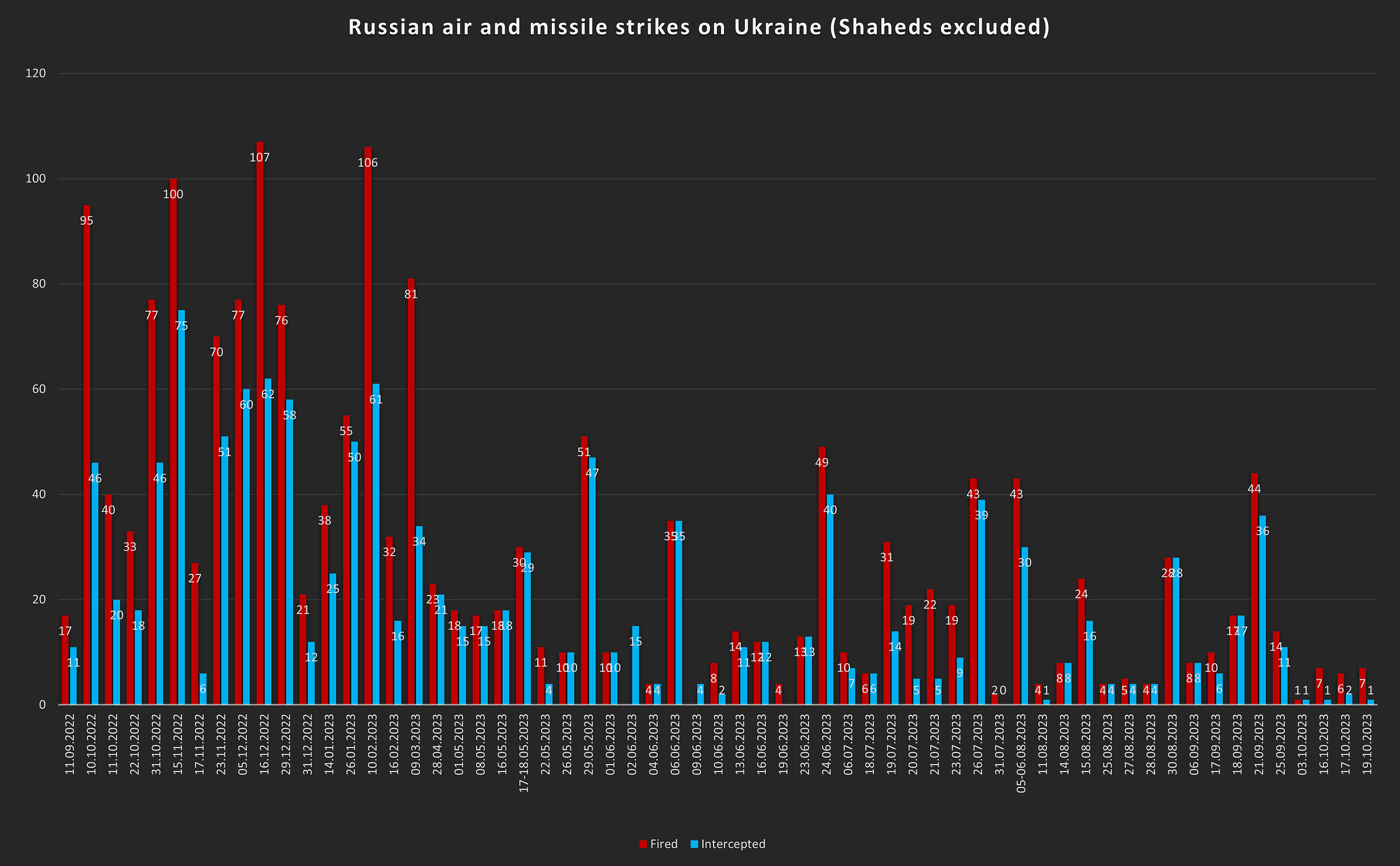
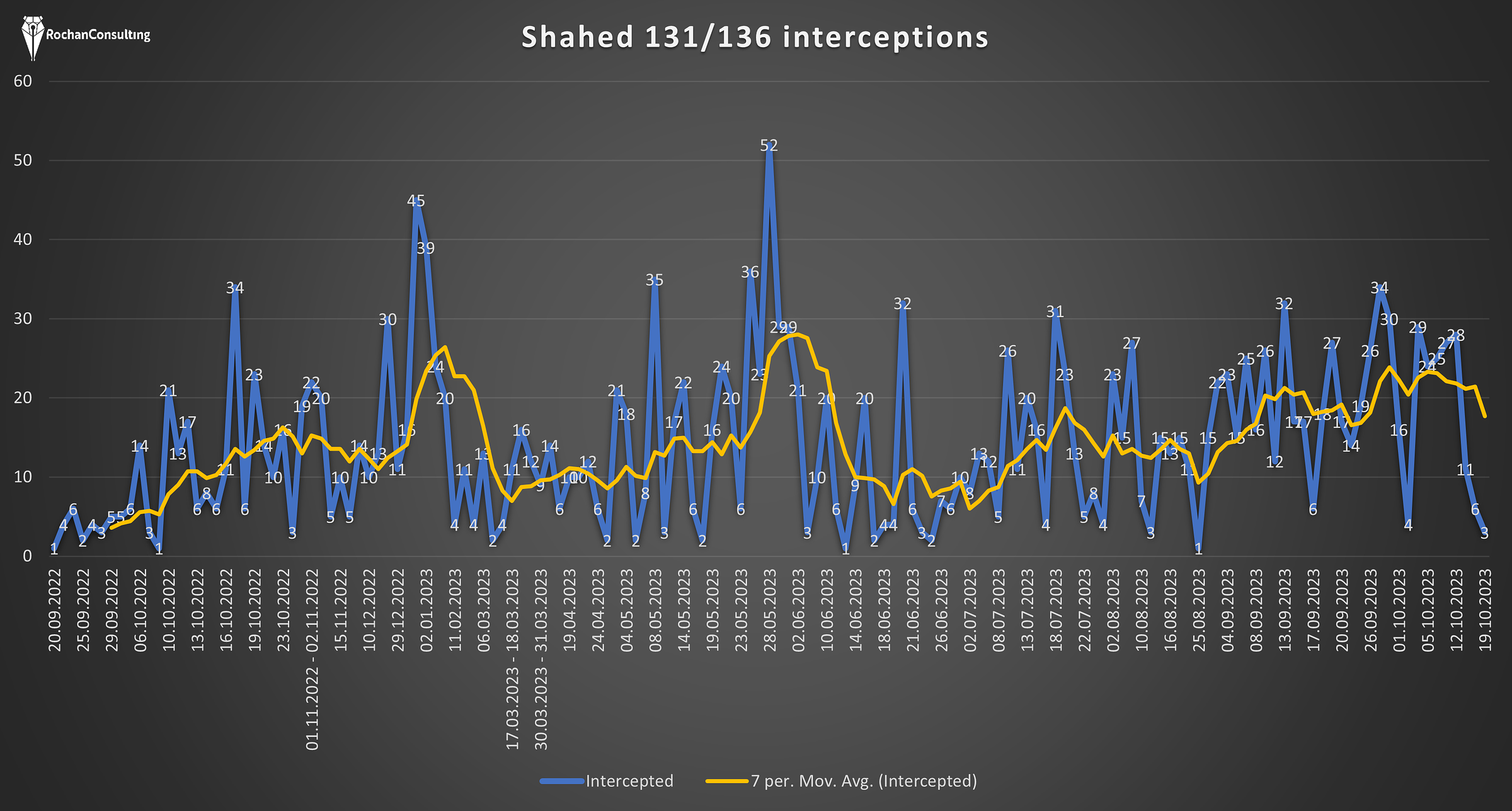
Outlook for the week of 14OCT-20OCT2023
In assessing the probability or likelihood of certain events, we use a set of terms proposed by the US Intelligence Community.
To introduce more accountability to our forecasts, each weekly update assesses how correct (or incorrect) our predictions were. Please also remember that while we try to remain as objective as possible regarding our performance, the reader will ultimately have to decide how (in)accurate we have been.
Previous forecast
“Regarding the Kharkiv Oblast Direction, we continue to expect no frontline changes. There is a small possibility that Russians will conduct cross-border raids, but they will certainly continue conducting artillery attacks across the region.” This assessment was correct.
Score: 1/1
“When it comes to the Luhansk Oblast Direction, we maintain that Russian ground attacks in the Kupyansk axis are highly likely to continue. It is unlikely that they will capture one village or more. We expect no Ukrainian gains in the region.” This prognosis was correct as well.
Score: 1/1
“When it comes to the Donetsk Oblast, let’s divide the forecast into possible Russian and Ukrainian courses of action. 1) Based on the overall Russian performance and troop deployments, Russians will likely make some territorial gains. We also assess that there is a roughly even chance that they will capture one village or more over the next seven days. This view refers to the Avdiivka area. 2) We assess that Ukrainians are unlikely to progress in the Kurdiumivka-Klishchiivka area. It is also highly unlikely that they will capture a village or more. We expect no major changes (one village or more captured) in other parts of the Donetsk Oblast.” This assessment was partly correct. Russians made very limited territorial gains near Avdiivka but did not capture any settlements. Ukrainians made no gains in the region.
Score: 0.5/1
“Moving onto the Southern Direction, we maintain that the Ukrainian progress will highly likely continue to be very slow, if non-existent. Ukrainians are highly unlikely to capture Verbove or Novoprokopivka. But, we also add that there is a roughly even chance that Russians will reclaim some territory in the Velyka Novosilka axis. We expect no Ukrainian gains in this area.” Ukrainians made marginal gains in the Orikhiv axis. Russians made no gains in the Velyka Novosilka axis.
Score: 0.5/1
“In the Kherson Oblast, we assess that Ukrainians will highly likely retain their forces on Dnipro’s left bank. They are also highly likely to continue conducting harassing attacks across the Dnipro. We now assess that Ukrainians could conduct a major river-crossing operation in the region, but, at present, we would not like to attach a probability score to this event.” This assessment was correct.
Final score: 4/5 (80%)
The forecast for the week of 21OCT-27OCT2023
Regarding the Kharkiv Oblast Direction, we continue to expect no frontline changes. There is a small possibility that Russians will conduct cross-border raids, but they will certainly continue conducting artillery attacks across the region.
When it comes to the Luhansk Oblast Direction, we maintain that Russian ground attacks in the Kupyansk axis are highly likely to continue. It is unlikely that they will capture one village or more. We expect no Ukrainian gains in the region.
When it comes to the Donetsk Oblast, let’s divide the forecast into possible Russian and Ukrainian courses of action. 1) Based on the overall Russian performance and troop deployments, Russians will likely make some territorial gains (Klischiivka area). Without additional troop deployments, they are unlikely to capture one village or more over the next seven days in the Avdiivka area. 2) We assess that Ukrainians are unlikely to progress in the Kurdiumivka-Klishchiivka area. It is also highly unlikely that they will capture a village or more. We expect no major changes (one village or more captured) in other parts of the Donetsk Oblast.
Moving onto the Southern Direction, we maintain that the Ukrainian progress will highly likely continue to be very slow, if non-existent. Ukrainians are highly unlikely to capture Verbove or Novoprokopivka. But, we also add that there is a roughly even chance that Russians will reclaim some territory in the Velyka Novosilka axis. We expect no Ukrainian gains in this area.
In the Kherson Oblast, we assess that Ukrainians are highly likely to continue (ground) attacking Russian positions on Dnipro’s left bank. But we cannot assess whether they will decide to 1) deploy more forces 2) expand the cross-river attacks horizontally.


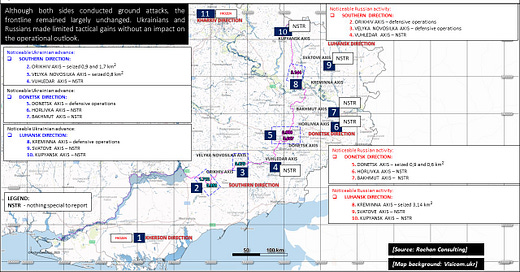



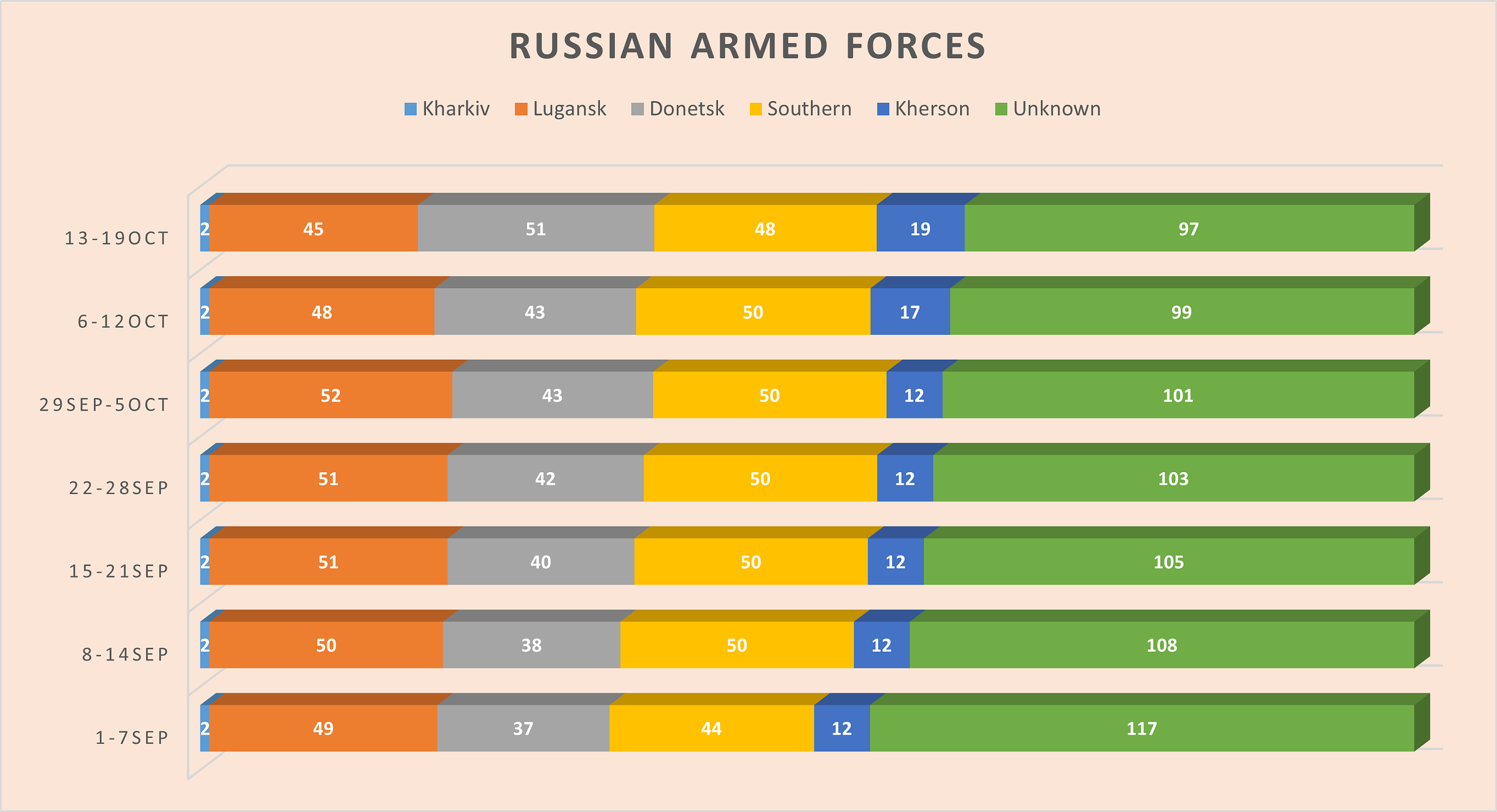

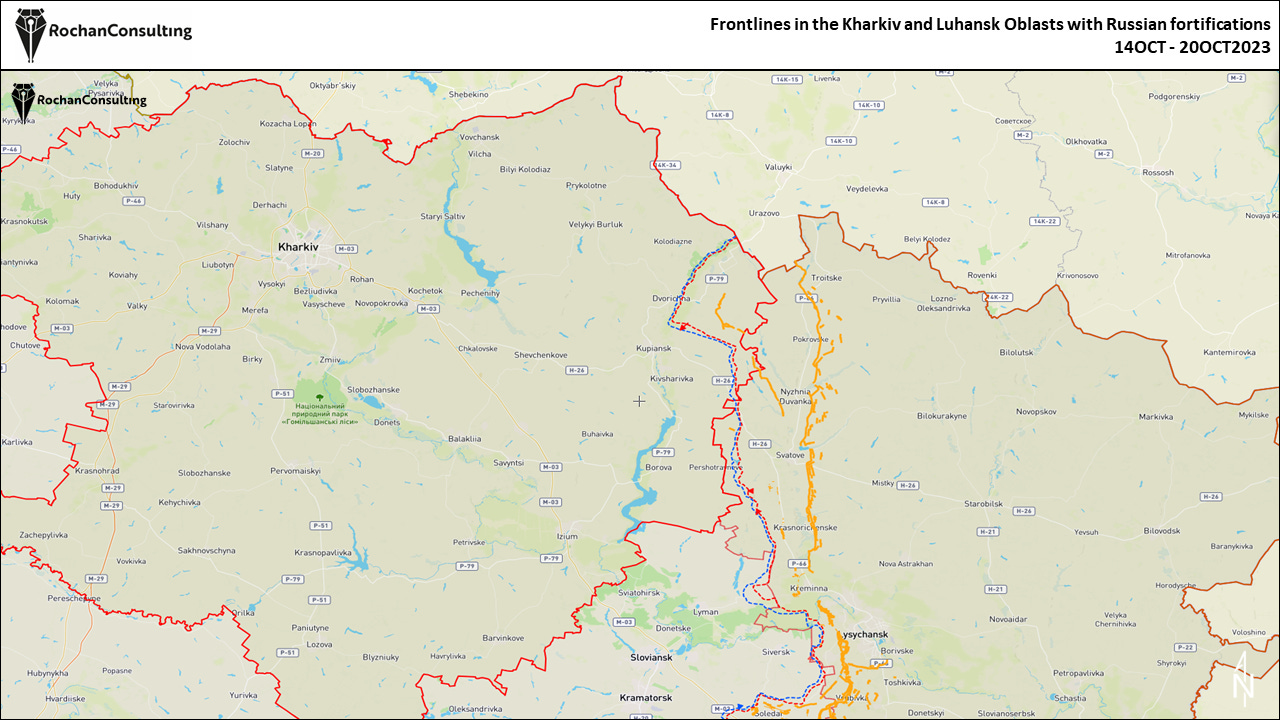

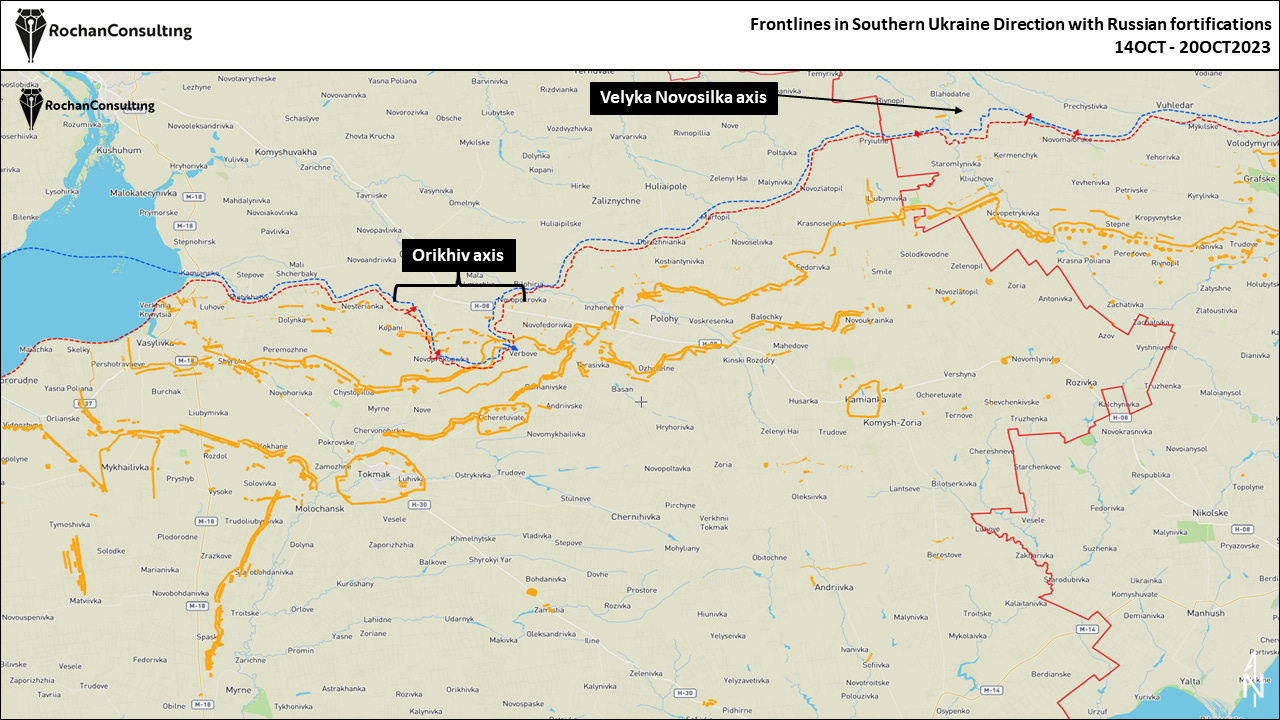
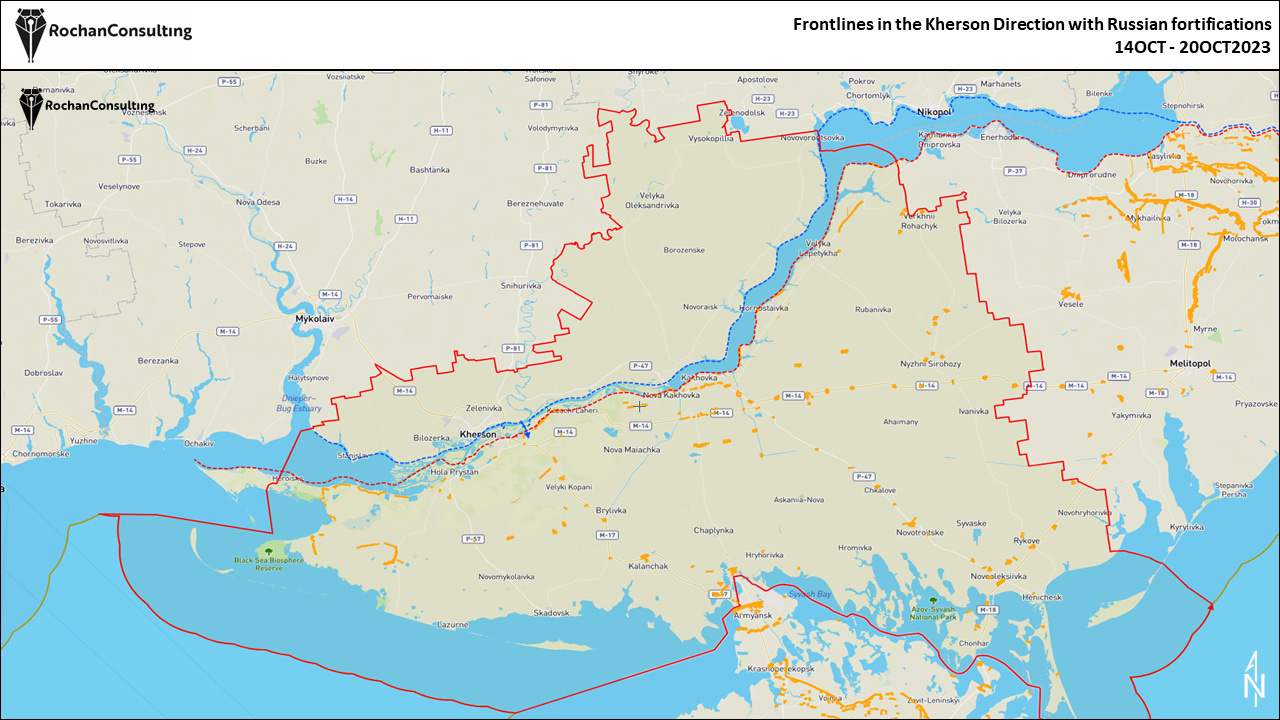

Astonishing detail, excellent sources. As always.